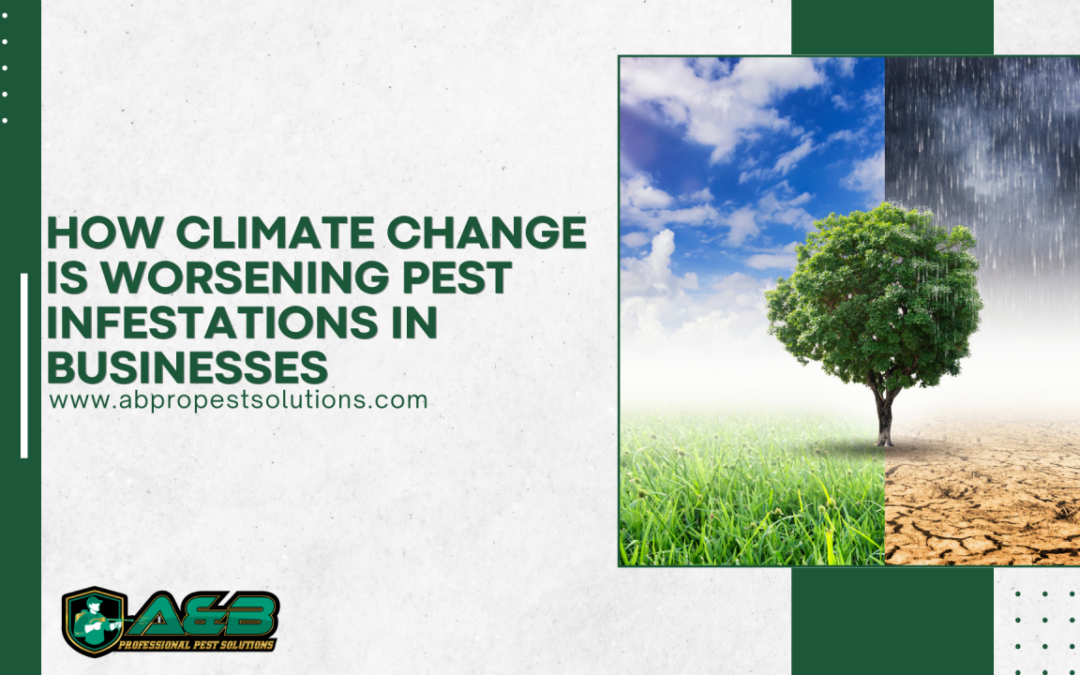Climate change is causing dramatic shifts in weather patterns, and one of its lesser-known consequences is the rise in pest infestations. Businesses across various industries are facing increased challenges as warmer temperatures, unpredictable weather, and higher humidity create the perfect breeding grounds for pests. These changes not only affect ecosystems but also disrupt industries such as food production, heath institutions, and retail, increasing the risk of financial losses, health concerns, and reputational damage.
1. Warmer Climates Mean Faster Pest Reproduction
- Many pests, including cockroaches, rodents, ants, and mosquitoes, thrive in warm environments. As global temperatures continue to rise, these pests reproduce at a faster rate, leading to larger and more persistent infestations. Warmer weather accelerates the life cycle of many insects, allowing them to mature, breed, and multiply at unprecedented rates.
- Businesses that once dealt with seasonal pest issues are now struggling with infestations all year long. Grocery stores, food processing plants, and restaurants, in particular, experience higher pest pressures as stored products and fresh produce attract insects and rodents seeking food sources.
- In addition, pests such as cockroaches and fleas are becoming increasingly resilient to conventional pest control methods, making it more challenging for businesses in the hospitality and tourism industries to keep their premises pest-free.
2. More Frequent Rainfall and Flooding Drive Pests Indoors
- Extreme weather events, such as heavy rainfall and flooding, force pests out of their natural habitats and into commercial spaces. Rodents, cockroaches, and ants seek shelter in food factories, grocery stores, warehouses, and restaurants, creating serious health and hygiene concerns.
- The excess moisture caused by flooding also fosters the growth of mold and bacteria, worsening the problem. Businesses in flood-prone areas must be especially vigilant, as standing water and damp environments attract pests like mosquitoes and termites.
- Flooding can also wash pests such as rats and cockroaches into new locations, increasing the spread of disease and making pest management even more difficult.
3. Extended Summers Increase Ants and Fly Populations
- Higher temperatures lead to prolonged summers, which extend the breeding season for ants, flies, and other insects. This increases the risk of food contamination in grocery stores, food production facilities, and hospitality businesses.
- Businesses with outdoor spaces, such as restaurants with patios or hotels with swimming pools, face an even greater challenge in keeping ants under control.
- The rise in fly populations also creates sanitation issues, as these insects are known carriers of harmful bacteria that can spread illnesses such as salmonella and E. coli.
4. Shifting Climate Patterns Encourage Pest Migration
- As temperatures rise, pests are expanding into new territories. Regions that previously had minimal pest issues are now experiencing infestations due to changes in pest behavior and migration patterns.
- Businesses that are unprepared for these emerging threats may find themselves struggling to address infestations of invasive species such as Aedes mosquitoes, fire ants, and agricultural pests that were once confined to warmer climates.
- This is particularly concerning for industries like agriculture and food distribution, where crop damage from migrating pests can lead to significant financial losses.
5. Increased Humidity Fuels Termite and Mold Growth
- High humidity levels create ideal conditions for wood-destroying pests like termites, which can cause extensive structural damage to buildings. This can lead to costly repairs and even safety hazards if infestations go undetected for long periods.
- Additionally, damp environments attract mold and fungus, which can lead to health hazards for employees and customers. Poor air quality caused by mold spores can contribute to respiratory issues, allergies, and other health complications.
- Businesses that rely on wooden infrastructure, such as restaurants, hotels, and retail stores, must be especially cautious and implement regular inspections to prevent damage from termites and mold.
How Businesses Can Adapt to Climate-Driven Pest Challenges
With pests becoming more resilient due to climate change, businesses must adopt proactive pest control strategies to mitigate the risks. Here are some key steps businesses can take:
- Regular pest inspections: Conduct routine inspections to detect and address issues early before infestations become severe.
- Improved sanitation and waste management: Properly store food, dispose of waste efficiently, and keep areas clean to eliminate food sources that attract pests.
- Climate-adaptive pest control solutions: Work with pest control professionals to implement solutions that are tailored to evolving pest behaviors.
- Sealing entry points: Ensure that cracks, crevices, and gaps in buildings are sealed to prevent pests from entering.
- Investing in moisture control: Use dehumidifiers and proper ventilation to reduce humidity levels and minimize the risk of mold and termite infestations.
- Employee training: Educate staff about best practices for preventing pest infestations and recognizing early signs of problems.
- Partnering with a professional pest control provider: Engaging with experts who understand the latest pest trends and mitigation strategies ensures long-term protection against climate-driven pest risks.
Protecting Your Business from Climate-Driven Pest Risks
With climate change influencing pest behavior, businesses must take proactive measures to prevent infestations. Regular pest inspections, improved sanitation practices, and climate-adaptive pest control solutions are essential in mitigating risks. Working with a professional pest control provider ensures that businesses stay ahead of these emerging threats and maintain a safe, pest-free environment.
By staying informed and prepared, businesses can minimize the impact of climate-driven pest infestations, protect their reputation, and maintain a clean and healthy environment for employees and customers alike.
To know more about A&B’s services, please visit the A&B’s website (www.abpestsolutions.com.ph) or Facebook Page (https://www.facebook.com/ABPestSolutions/) to know more about their services. A&B also disinfects workplaces or houses to kill COVID-19 Virus.
You may also contact: +63 905 496 4550 and +63 951 062 4830
A&B Professional Pest Solutions Corporation is located at the Ground Floor of Monterey Building at Genesis St., Centro de San Lorenzo, Santa Rosa, 4026 Laguna, Philippines

